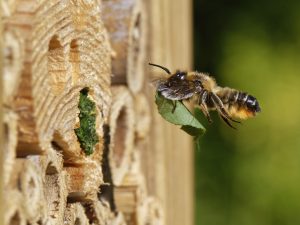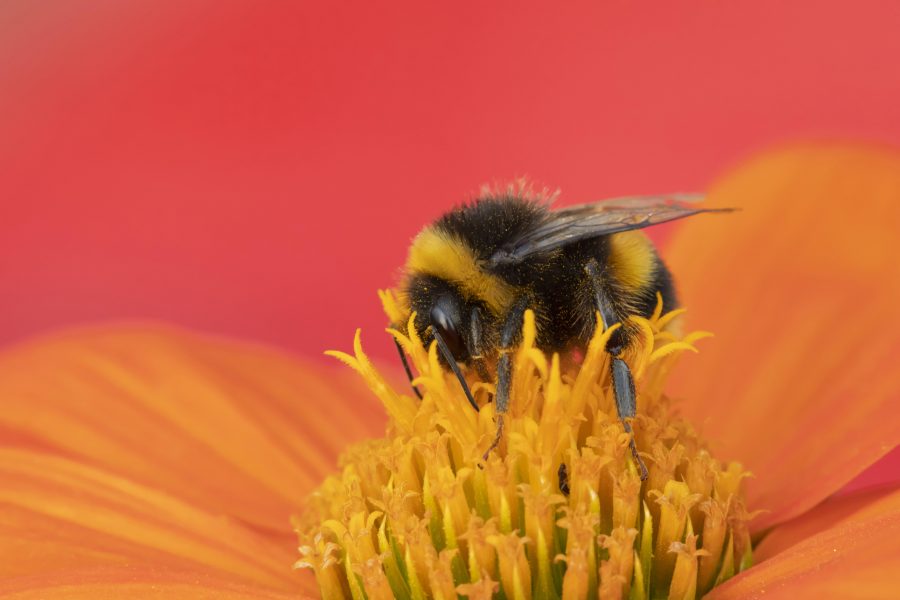This World Bee Day, the RSPB is offering expert tips on creating a bee-friendly garden.
The UK and Ireland are home to over 270 species of bees — you can learn about some of them with this bee identifier chart — and many of these play an incredibly important role within their ecosystems, pollinating crops and wildflowers.
Not many insects have an entire day in the global calendar dedicated to them, but then again, not many are quite as important to the future of the planet as bees. So, why are bees so crucial, what are the biggest threats to their existence, and how can you help protect vital bee populations?
Why are bees so important?
These hard-working critters play a crucial role in the biodiversity of our planet, with around three-quarters of global food crops depending on pollinators such as bees. In fact, one in every three mouthfuls of the food we eat relies on pollination.
By carrying pollen from one flower to the next, bees and other pollinators enable the abundant production of vegetables, fruits, nuts and seeds, contributing significantly to overall food security and nutrition. To illustrate just how significant bees are to the future of our planet, here are some key statistics:
- According to the Food and Agriculture Organization of the United Nations, pollinators such as bees are responsible for increasing the output of 87 of the world’s global food crops.
- In the UK, bees and other species pollinate almost £700 million worth of crops annually.
- If bees disappeared, it would cost UK farmers up to £1.8 billion a year to pollinate their crops manually.
Are bees endangered?
Sadly, it’s estimated that 35 bee species are threatened with extinction in the UK (added to the 13 we’ve already lost), with the following factors thought to be mostly to blame:
- Habitat loss: the greater spread of urban developments and increasing intensity of farming methods mean that precious bee habitats are rapidly disappearing — we’ve lost 97% of flower-rich meadows in the UK since the 1930s.
- Pesticide use: bees and other pollinators are also threatened by the heavy use of pesticides and insecticides, which are used in agriculture to control weeds and insect infestation. The use of these chemicals makes bees vulnerable to poisoning and death.
- Climate change: one of the several concerning impacts of climate change is the effect it is having on bee populations, with extremes in weather disrupting their nesting behaviour and playing havoc with seasonal timings.
So, with bee habitats rapidly disappearing and more and more bee species threatened with extinction in the UK, how can you do your bit to help protect these stripey biodiversity champions?
 How to create a bee-friendly garden
How to create a bee-friendly garden
With bee habitats declining across the UK and the world, you can help to create a safe haven for these indispensable pollinators in your own backyard. By making a few simple and inexpensive changes to your outdoor space, your garden will be filled with the gentle hum of these furry visitors as they go about their important business.
This video from Adrian Thomas, the RSPB’s Wildlife Gardener, provides expert tips on creating a wildlife-friendly garden. “Doing things to help wildlife in your garden is so rewarding,” Adrian says in the video, and his advice includes bee-friendly planting and providing shelter for visiting bees.
When it comes to specifically creating a bee-friendly environment in your garden, here are the RSPB’s top tips:
- Plant wildflowers: according to Adrian, plants are an “absolute bedrock of the wildlife-friendly garden”, and of course they’re essential for pollinators such as bees and butterflies. Wildflowers such as lavender, heather and honeysuckle create a “riot of colour that’s great for bees”, and you can sew plenty of annual wildflowers using this ‘best for bees’ seed pack.
- Introduce a ‘bee hotel’: “If there’s one group of creatures you can help in the garden in terms of providing shelter”, says Adrian, “it’s solitary bees.” We have 225 species of solitary bees in the UK, and with their natural habitats declining, you can offer them somewhere to nest by installing a bee-friendly dwelling such as a solitary bee home or bee biome. Adrian’s advice is to place your bee home in a south-facing spot where it can get plenty of sun.
- Avoid using pesticides: one of the biggest contributors to declining bee populations, pesticides are extremely harmful to bees, so you should avoid using them if you want to create a bee-friendly environment. Opt for natural fertilisers to keep your plants strong and able to fend off pest attacks.
- Let the weeds grow free: Though there are certain areas of your garden you’d prefer to keep weed-free, consider leaving a corner or two of your garden undisturbed, allowing weeds to grow naturally. ‘Weeds’ such as dandelions and lawn clovers provide vital pollen and nectar for visiting bees.
- Provide some liquid refreshment: bees need to stay hydrated to keep pollinating, and Adrian would encourage everybody with a garden to “add water in some form” to benefit wildlife. This handy guide from the RHS shows you how to create a wildlife pond, but alternatively, you could simply place a tray in your garden, fill it with a bit of water, and line it with rocks for passing bees to stop off and have a drink.
- Help a bee in need: if you spot a solitary bee immobile on the ground, particularly during summer, it may be feeling a little weary and need a helping hand to get going again. Mix two tablespoons of white sugar with a tablespoon of water and place it next to the bee. This homemade concoction will give the bee an instant energy boost to help them on their way!
A future without bees isn’t a future worth thinking about — their extinction would alter the delicate balance of the world’s ecosystem and significantly affect the global food supply.
And while the biggest threats to bees are climate change, habitat loss, and the heavy use of pesticides, we can all do our part to protect and preserve these precious creatures. If you’re lucky enough to have a garden or even a balcony, just making a few small changes can make a huge difference to bee populations.
Images: RSPB Images
More news like this can be found in The Country Smallholder magazine. Subscribe here.
For FREE updates from the world of smallholding, sign up for The Country Smallholder newsletter here.








